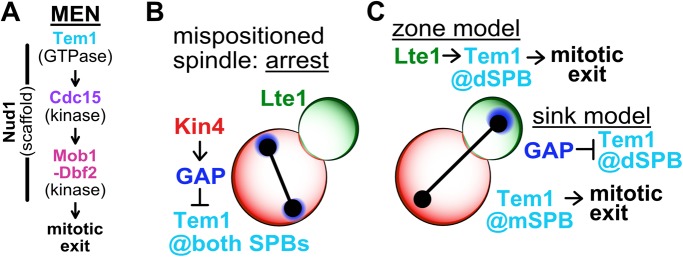FIGURE 1:
The MEN and models describing MEN regulation by spindle position. (A) The MEN. The GTPase Tem1 recruits the protein kinase Cdc15 to SPBs. Activated Cdc15 phosphorylates the SPB-associated scaffold Nud1, recruiting the protein kinase-complex Dbf2-Mob1 to SPBs. Cdc15 activates Dbf2-Mob1 at the SPBs and Dbf2-Mob1 then triggers exit from mitosis. (B, C) The MEN is regulated by spindle position. (B) When anaphase spindle elongation fails to occur along the mother–daughter axis, leaving the spindle and both SPBs in the mother cell (mispositioned spindle), the MEN does not become active and cells arrest in anaphase. Asymmetric localization of the MEN inhibitor Kin4 to the mother cell prevents Tem1 activity at mSPBs by modifying the MEN GAP complex, Bub2-Bfa1. (C) Anaphase spindle elongation along the mother–daughter axis delivers a SPB into the daughter cell, activating the MEN and causing cells to exit from mitosis. The zone model describes a MEN-activating zone in the daughter cell and a MEN-inhibitory zone in the mother cell governed by Lte1 and Kin4, respectively. Tem1 is activated at the dSPB by Lte1, causing mitotic exit. The sink model posits that the dSPB acts as a sink, sequestering the MEN GAP complex away from the mSPB and inhibiting Tem1 at the dSPB. Sequestration leaves Tem1 uninhibited at the mSPB, activating the MEN and causing exit from mitosis.

